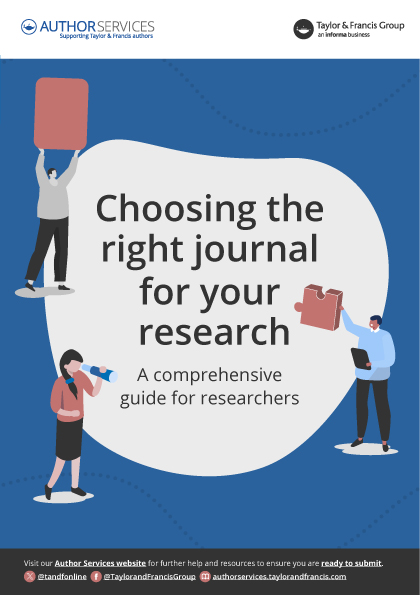5 ways to avoid the wrong journal and find the right one
We asked over 700 researchers and authors who downloaded the Taylor & Francis publishing journey free guides to share their academic publishing experience before and after using the downloaded free guides.
This blog post was prompted by the responses we received from those that downloaded the Choosing the right journal for your research free guide. Popular feedback revealed that the core insights from the free guide helped researchers understand how to avoid the wrong journal and find the right one.
You may or may not already have a journal in mind to submit your manuscript to. Whatever your situation is, read on for what to consider to avoid choosing a journal that is not a good fit for your research.
1. Where to start when choosing a journal

One of the most common reasons editors reject research manuscripts is because they do not fit the journal it was submitted to.
This can be in regards to the goals and scope of the journal or the needs and tastes of its readership.
As with the rest of your work, you will need to carry out some research to be able to choose a suitable journal for your research.
Simply choosing a journal because it’s where your colleagues have published, or you have always wanted to publish there is not a good enough reason to choose a journal.
The first chapter of our choosing the right journal for your research free guide will discuss in detail the steps you can take to develop a list of suitable journals. You will also have access to our choosing a journal checklist to walk your way through, to help you find the best journals for your work
There are also other tools and resources available to help you build your list of possible journals to publish in.
“Choosing a journal as the first step to publishing proved to be very important. I used to write my articles on my preferred topics and send them to journals. I ended up with frequent rejections, but when I choose a journal first and followed the principles from the free guide, it became easier to contribute to ongoing debates in the journals, which was easier for one’s articles to be accepted.”
Grace Tomoka
Post information
Related posts
2. Choosing a journal from your shortlist
Now you have a list of journals that could be a good fit for your research, it’s time to narrow down that list. You will have to engage in some serious detail gathering and investigation on your shortlist of journals against several factors.
One of the key factors to consider is to get familiar with the content of journals. Reviewing past issues of the journals you’re interested in is the first step to narrowing down your choice. By familiarizing yourself with the content the journal publishes, you’ll gain a greater understanding of whether your own research is the right fit for it.
So, take some time to download and read this free guide to learn about other important factors you’ll need to consider when it comes to picking the right journal for you.

“The free guide provided useful information for which journal to submit.”
Peter Charles Lippman
3. When is open access the right publishing option?

Choosing to publish your research open access (OA) makes it freely and permanently available online. By opening up research to anyone, open access helps accelerate greater engagement, collaboration, and dissemination of research.
Your publishing option is another question you need to have answered when choosing the right journal to fit your work. Do you want it to be available to journal subscribers only? Or do you want it to be open access – where anyone can read and build upon your work?
“The free guide provided insights and encouragement to research more on each subject of interest which have received plausible responses from target readers as I improve in disseminating alternative perspectives.”
Letlhage Mochadibane
4. How much should you rely on journal metrics and how is it calculated?
If you regularly hear colleagues talking about Impact Factor, Altmetric Attention Score, SJR, SNIP, Cite Score, etc., but don’t fully understand what these mean—we can help you. Here we provide a quick guide to the most relevant journal metrics that you can use when selecting a journal for your paper.
Knowing the most relevant journal metrics can help you to make a better decision regarding which journal you’ll aim for. So, what do all the different metrics mean? And how are they calculated? There are various things to be aware of when assessing journal metrics, it’s vital to know what the best approach is when dealing with journal metrics.
We’ve put together a guide to help you answer these questions with a quick overview of the metrics you can download for free.

5. How to avoid predatory journals
With lots of new academic titles launched every year, deciding whether or not a journal is worthy of your work can be rather difficult. An unfortunate side-effect of these launches has been the rise of predatory journals and publishers.
As a researcher, how do you evaluate whether the journal you’re about to send your work to is the real deal? Reputable journals will provide clear details about their peer review process, as well as information about open access fees.
Note that predatory journals will try to mimic high quality journals but common markers to spot predatory journals include no or little detail of the peer review process, unclear fees, no or fake editorial boards, wrong information about indexing and more.
Working out which journal to target is just as important as knowing which journals to avoid. Reputable journals themselves vary considerably in terms of reputation and ranking, so make sure you take a look at our free guide on choosing the right journal for your research.
Learn how to find the right journal for your paper

“The free guide provided me with important information about the process to publish in a reputable journal.”
Yeni Januarsi, Universitas Sultan Ageng Tirtayasa
Where to next?
If you’ve found these tips helpful, take a look at:
The Taylor & Francis journal suggester – to help you find the best home for your research.
5 practical tips for writing your paper – to produce a manuscript that will meet your target journal’s standard.
Our Insights newsletter – the latest news, tips, and resources delivered straight to your inbox.